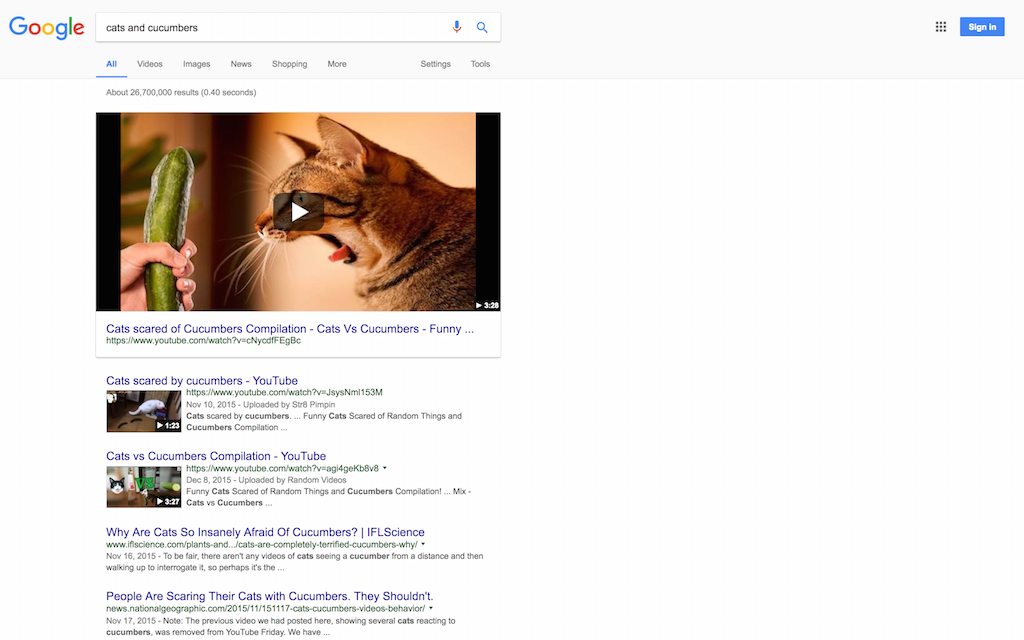Video content has grown to become an effective medium in driving website traffic, creating engagement, and enhancing user experience – ultimately leading a website to an elevated ranking within the SERP’S (Search Engine Results Pages) if executed in a strategic and well thought out way. Yes thats right – SEO. This article will examine how video can improve website SEO as well as optimisation elements that you should consider when planning for video implementation.
According to Cisco, “video traffic will be 82 percent of all consumer Internet traffic by 2020” – a 70% increase from 2015. This statistic reflects the importance of video and the need for your company or business to jump on the video bandwagon. Not just for the sake of video’s obvious advantages but for the pure fact that this is what Google’s algorithm is wanting it at an ever increasing rate.
HOW VIDEO IMPROVES WEBSITE SEO
Using Video on a Landing Page
Video has the ability to improve ‘dwell time’ on a website, a metric used by search engines like Google, to determine how trustworthy the content of a website is to web users. ‘Dwell time’ on a website measures the session duration a visitor spends on (or dwells upon) a website. With its audio and visual stimuli, video engages people for longer as opposed to static images or text, thereby increasing dwell time on a website. An increase in dwell time indicates to search engines that the content is trusted by users – pushing the page and website higher in ranking.
To implement a video on your landing page, there are two options you can go through:
- Hosting a video on your own website.
- Embedding a video via a hosting platform such as YouTube or Vimeo (recommended)
A lot of people find the of process self-hosting a video more complicated than embedding a video. When self-hosting a video, complications arise such as server bandwidth, various video formats, and coding (WP101.com details the complications when self-hosting a video). However, if you do choose to self-host your video, Amanda DiSilvestro has outlined a simple way of optimising a self-hosted video.
On the contrary, the process of embedding video onto your website, for example, via YouTube, is made a whole lot easier. With easy integration through shortcode embeds on social media platforms, and as a Google brand, YouTube (the second biggest search engine after Google) gives an audience the speed and accessibility to engage with, and share videos across platforms. In addition, the host has the ability to measure the performance of their video through Google Analytics and YouTube’s analytics and reap the SEO rewards if optimised and strategic enough in content and application.
Depending on the nature of your website, various video styles can be beneficial to improving the ’stickiness’ of your website. ‘Stickiness’ is similar to dwell time, however it is used as a term rather than a metric to describe the amount of time a visitor spends on your site. Below are some successful examples of different video styles and how they have been used on a landing page.
SEO Sydney Background Video:

Using video hosting platforms like YouTube to embed a video on a landing page does have its SEO advantages of being found as a rich-snippet in the Google Search Results Page. However, it sometimes may not be enough to drive the desired amount of traffic to your website. By simply adding your video to your landing page will not always guarantee the amount or type of traffic you desire. This is where the emphasis on social media marketing comes in, and how it can drive traffic to your website.
Using Video on Social Media
Giving a business or brand an active presence on social media (including Facebook and YouTube) can help boost a website’s ranking on Google. Google can detect elements of a website’s social profiles such as the number of organic followers, as well as the level of engagement or as we hear a lot of ‘heat’.
A great way to build a following and create engagement is by adding video content to your social media channel(s), but keep in mind that for your video to attract a large audience, it needs to be worthy of a ‘like’, ‘comment’ or ‘share’. In a blog post on Kissmetrics.com, author, Josh Hardwick emphasises that a video “needs to evoke a strong enough emotional reaction that they’ll (your audience) want to share it, either by clicking the Tweet/Share button or by writing a post about it on their blog/website (with a link back to your site, of course)”.
A strong social media presence via video content can boost your Google ranking. As we have been discussing, video content has the high potential to receive a high level of engagement (likes, comments, shares, etc.) amongst an audience. Content that receives a high level of engagement is a metric that Google uses to identify relevant and high-quality information. If an engaging video on a social media platform is classed to be of relevant and high-quality information by Google, Google will then elevate the ranking of the associated website if it can identify a direct link from the video.
Examples of successful video that evoke emotion:
VIDEO OPTIMISING ELEMENTS TO CONSIDER
Defining Goals
Although anyone can make a video from any camera device, it’s important to note that some websites require a more professionally made video, which can sometimes be a costly investment. As this can be the case, it is important to clearly define your goals so that you obtain the best ROI on your video.
Some general goals can be to:
- Increase Conversions
- Increase Reach
- Build Links
- Give your website a face
- Introduce your website
- Educate your customers
- Product Demonstrations
Even if you don’t require a professionally made video, a clearly defined goal can give a video purpose to an audience.
Knowing Your Audience
Another important factor to consider when planning the implementation of your video is your audience. It is important to ask yourself the following questions:
- Who do I want to see and engage with my video?
- How will my audience encounter my video? Will it be through a Google search query, social media, or a backlink from another website?
- When is the best time to post my video – when will my audience be most active online?
- Which region(s) should I target my video at – where does my audience reside?
- How will my audience view my video; will they use a desktop computer, mobile device or both?
- If the bulk of my audience will use a mobile device to view my video, is my website optimised for mobile devices when they click on the link to my website?
Another advantage of using a video hosting platform is that videos uploaded to YouTube can be played on mobile devices.
Video Keyword Research
In comparison to using keywords to optimise websites, video keywords return YouTube video results in the Google results page. Brian Dean has published a great post on Backlinko.com, detailing the process on ‘how to do video keyword research’. In summarising Brian’s post, simply use keywords in your niche to see if they return video results in the Google results page. You will see these results as video rich snippets – and apparently, YouTube video results will rank higher in the Google results page than web pages (logic being YouTube is a Google product) – more reason to implement video content within YouTube. The next step is to check your keywords in the Google Keyword Planner.
Optimising Video on a Hosting Platform
In the case of using YouTube as your choice of video hosting platform, it is important to optimise the following YouTube meta data elements to yield the best SEO results possible. Doing so allows Google to understand what your video is about and to deliver your video as the most relevant content to your desired audience.
Be sure to optimise:
Video Title: at least 5 keywords in length
Video Description: Very important to optimise as it helps Google to understand your video. It should be at least 250 words in length whilst incorporating your keywords, 3 to 5 times. A good tactic is to use a transcript of your video in this section. And most importantly, provide your website link at the top of the description to drive traffic back to your website.
Tags: Again, it is good to use keywords as your tags.
Ensure that all elements are relevant to the subject or content of your video. If your elements are irrelevant, you risk damaging your audience retention score and therefore, Google ranking. Other platforms such as Vimeo and Wistia incorporate similar principles when scanning video content and its optimisation elements.
If you have a range of videos on both your website and YouTube channel, a good optimising practice is to categorise your videos to improve usability – another Google ranking factor. Usability refers to how easy it is for a user to perform tasks and navigate through information on a website. You can see how we categorised our SEO tutorials on our SEO TV web page. Categorising your videos on YouTube will also extend the reach of your video(s) to the home page of YouTube, thereby driving more traffic to your videos and website.
CONCLUSION
So now that you have all of your video elements optimised, your video content should be matching relevant search queries and ranking higher in the Search Engine Results Pages (SERPs). However, to elevate and maintain your ranking (through video), you need to constantly create engaging content – content that provides value to your audience. The more engagement your video content receives, the higher it will rank in the SERPs. Again, Brian’s great post on backlinko.com outlines various metrics that YouTube uses to determine the quality of your video.
There are all sorts of statistics that reflect the benefits of using video to achieve website goals and to improve a website’s search ranking. If you are not implementing video onto your website or content strategy, you may be missing out on that 200-300% click through rate, or that 80% conversion rate – just to name a few. It doesn’t have to be a costly investment, just great content – so get to it, and start filming. If you would like help with this, or anything else SEO-related, check out SEO Company Melbourne – the experts in all things SEO











